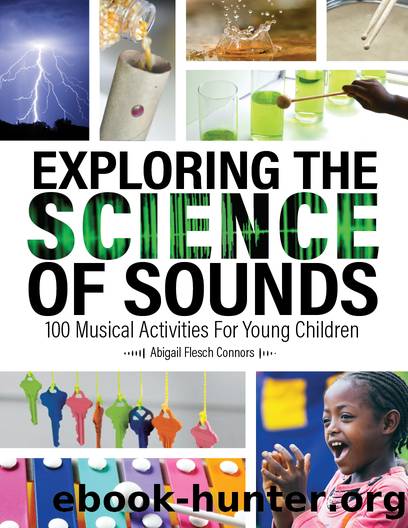Exploring the Science of Sounds by Abigail Flesch Connors

Author:Abigail Flesch Connors
Language: eng
Format: epub
Publisher: Gryphon House Inc.
Published: 2017-06-19T19:44:37+00:00
This has been one of my studentsâ favorite activities for years. I always use the same green, plastic coffee can for the game, so when they see me bring it out they know whatâs coming and get excited. Children love guessing games, but of course this is a special kind of guessing gameâone in which theyâre making âeducated guesses.â These guesses should be grounded in their knowledge and sensory experiences.
What Youâll Need
Plastic coffee can
Variety of items, such as small jingle bells, wooden and/or plastic beads, paper clips, sand, wooden blocks, twist ties, plastic tags from bread loaves, cotton puffs, small plastic manipulatives, plastic bottle caps, small bouncy balls, plastic building bricks, erasers, small pebbles, acorns (unless someone has an allergy to tree nuts), seashells, and so on
Activity to Try
Ahead of Time:
Fill the container halfway with one of the items you have gathered.
With the Children:
1. Start things off with a flourish, bringing out the can and announcing, âAnd now itâs time for the Mystery Music Can!â Wonder aloud what could be in the can. Give the can a shake and look surprised and intrigued. Ask the children if they think it will sound the same if you shake it again. Listen to their responses. Try it so children can hear that it does sound the same.
2. Pass the can around the circle. Each child can shake it for a few moments and listen to the sound carefully. Remind them not to open it and not to shake it too hardâthey could accidentally hit themselves in the face or bump the can on the floor, making the lid pop off. Children should shake it just hard enough to hear the sound. They may want to shake it near their ears.
3. After everyoneâs had a turn, ask the children if they think they know what might be inside. Children should raise their hand before calling out. Theyâll need to be reminded of this because they get very excited and canât wait to tell everybody their guesses.
4. When everyone who has a guess has shared it with the group, reveal the contents of the can. So that the whole group can see more easily, I usually pour some of the items out in my hand rather than just holding out the lidless can.
Questions to Ask
⢠Youâve asked them what they thought was in the can. But remember to ask, too, how they came to their conclusion. Listen to their ideas.
⢠Then you might say something like, âEven though he didnât get the right answer, Vihan made a very good guess, because it showed he could tell the things inside were small and hard.â This kind of comment communicates to children that thinking logically is valuable and important.
⢠What were you thinking of when you tried to figure out what was inside?
⢠Did you think of other things youâd heard that sounded like it?
Discovery to Make
Children can identify sounds by careful listening and by thinking of other objects theyâve heard that have the same or a similar sound.
Download
This site does not store any files on its server. We only index and link to content provided by other sites. Please contact the content providers to delete copyright contents if any and email us, we'll remove relevant links or contents immediately.
The Complete Stick Figure Physics Tutorials by Allen Sarah(7339)
Secrets of Antigravity Propulsion: Tesla, UFOs, and Classified Aerospace Technology by Ph.D. Paul A. Laviolette(5338)
Thing Explainer by Randall Munroe(3911)
The River of Consciousness by Oliver Sacks(3574)
The Order of Time by Carlo Rovelli(3164)
How To by Randall Munroe(3078)
A Brief History of Time by Stephen Hawking(2994)
I Live in the Future & Here's How It Works by Nick Bilton(2963)
What If?: Serious Scientific Answers to Absurd Hypothetical Questions by Randall Munroe(2670)
The Great Unknown by Marcus du Sautoy(2666)
Midnight in Chernobyl by Adam Higginbotham(2520)
Blockchain: Ultimate Step By Step Guide To Understanding Blockchain Technology, Bitcoin Creation, and the future of Money (Novice to Expert) by Keizer Söze(2467)
Networks: An Introduction by Newman Mark(2383)
The Meaning of it All by Richard Feynman(2320)
Easy Electronics by Charles Platt(2310)
The Tao of Physics by Fritjof Capra(2247)
Midnight in Chernobyl: The Untold Story of the World's Greatest Nuclear Disaster by Adam Higginbotham(2200)
Introducing Relativity by Bruce Bassett(2098)
When by Daniel H Pink(2098)
